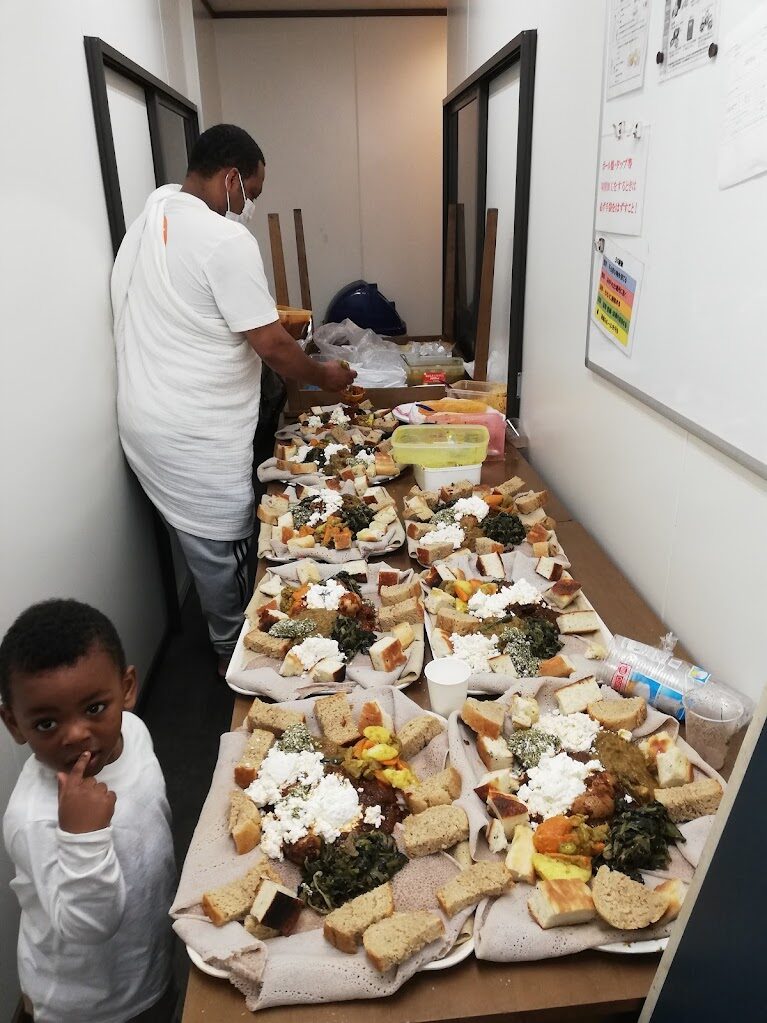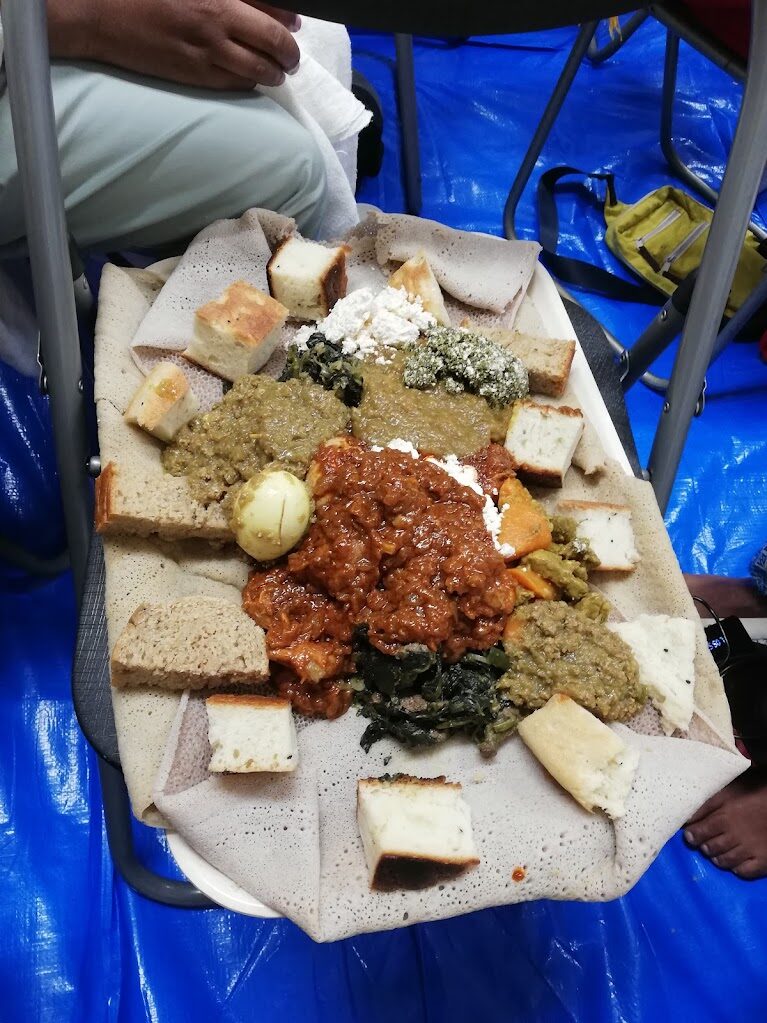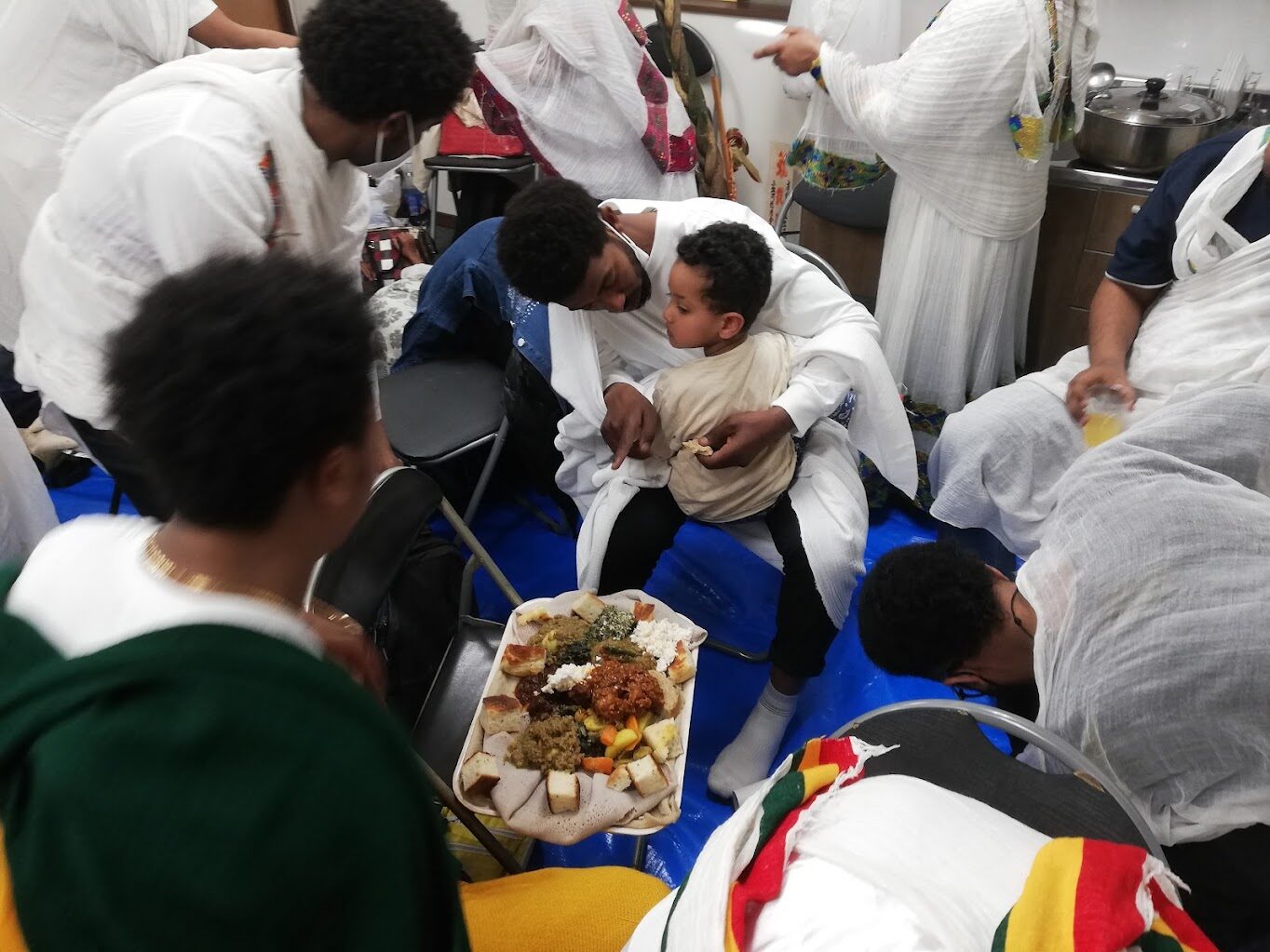
Gursha in Tokyo
English translation : Yui Okada, Aki Yahata
One evening in late April, 2022, I headed to a little area on the outskirts of Sumida Ward in Tokyo, where small-scale factories are clustered, trying to suppress my excitement. I was going to be participating in the Fasika, Easter service of the Ethiopian Orthodox Christian Church (hereinafter referred to as the Ethiopian Orthodox Church), held by Ethiopian immigrants living in Japan. The place my Ethiopian friend who was organizing the service asked me to come was a staff canteen on the second floor of a factory. There were about 40 people, believed to be Ethiopians, who were clad in Gabi–white cotton cloth, and they were offering prayers with enraptured expressions as they faced images projected with an LCD projector on the wall in front of them. Everyone held their palms up in front of their chests, pointing toward the sky, and repeating the words “Amen, Amen.” Children were sleeping on the floor.
As the participants beckoned me, I slowly walked into the group. In the video on the front was an Ethiopian bishop, who was participating online from Minnesota, USA, was reading the Bible aloud in Amharic—the local language of Ethiopia. The smoke and smell of frankincense filled the room. It is amazing how a room in a factory in downtown Tokyo has transformed into a space for a solemn Orthodox ceremony.


I have been visiting the Federal Democratic Republic of Ethiopia since 2001 for anthropological field research. Ethiopia is located in the northeastern part of the African continent and has an area approximately three times the size of Japan, containing more than 80 ethnic groups. When people think of Ethiopia, many visualize world-renowned long-distance runners and coffees such as Mocha and Yirgacheffe. However, their unique food culture formed around fermented foods, and the communication between people around the food is something to keep in mind. In 2019, Prime Minister Abiy Ahmed awarded the Nobel Peace Prize is still fresh in our memory. The prize was for recognition of his various innovative efforts including the resumption of diplomacy and making peace with neighboring Eritrea which had constant conflict with. However, the following year, in 2020, fighting broke out in the north between the Ethiopian federal government forces and the Tigray People’s Liberation Front (TPLF), which had long been the core of the Ethiopian government. Unfortunately, the political situation in the country hasn’t been stabilized since then.
With the country in such a difficult state, did you know that the area around Yotsugi Station in Katsushika Ward has recently been called “Little Ethiopia”? Many Ethiopian immigrants live and work around Katsushika Ward and Sumida Ward. Since about 2009, there irregularly has been held the only Ethiopian Orthodox church gathering in Japan, using local community centers, houses, or factories. Also there are a lot of interactions between Ethiopians and even with their Japanese neighbors through Ethiopian food. The Ethiopian Orthodox Church is an old sect with a history dating back to the 4th century. It was the state religion during the period of the Ethiopian Empire, which lasted until the early 1970s, and still today almost half of the population, mainly of northern Ethiopia, follows it and it has a great influence on the lives and ways of thinking of the general public.
Let’s return the story to the Sumida Ward’s Easter festival. The ceremony started at 10pm and gradually heated after midnight. Among the participants, about six men and women faced each other and began to loudly sing the hymn Mezmul. A man powerfully beats a ceremonial drum called “kebero”, the singers held ceremonial wooden staffs, with their right hands holding a metal instrument called “tsanatsel”. This instrument is swayed from side to side to create a cheerful rhythm. Then they hit the ground with the tip of their staffs. This symbolizes the image of Jesus Christ being scourged. Furthermore, the swaying of the tsanatsel from side to side and the beat of the drum are said to represent the image of Jesus Christ, who is staggering and slowly walking after being beaten by the crowd. Hymns, sermons, and Bible readings went on and on without a break.
Near the dawn, as I began to doze off, the ritual seemed to have come to an end. A plate with injera, gray bread made from tef which is a grain of the grass family— major staple food for Ethiopians, and side dishes of meat were served to participants. They each brought small amounts of Ethiopian spices and other ingredients unavailable in Japan from home, and they all worked together to prepare the dishes at the venue.


Several people sat in a circle, wrapping mutton or chicken in injera with their hands, and stuff their mouths with it. The participants’ fingers and backs of their hands were dyed reddish-brown from the spices and side dishes. According to what I heard while eating, everyone has different jobs in Japan: workers from waste oil recovery plants, automobile factories, caregivers, and waiters at restaurants. There were also several employees of the Ethiopian embassy. A few international students from graduate schools in the Kanto region also participated.
In the meantime, the participants began to perform Gursha with each other. It is one of essential forms of communication in Ethiopian food culture. Grusha is a practice of bringing injera to the mouths of people present at a meal and feeding them. This is a gesture of welcoming, camaraderie or bonding. If a piece of injera comes near your mouth as a Gursha, you have no choice but to eat it. It is considered as rude to refuse it. Furthermore, if you are given injera as a Gursha, it is considered proper etiquette to give another to that person in return. Reddish-brown hand suddenly appears at your mouth from front and back, after you finished your fill of injera, it is a bit too much. This clearly indicates when you have a dinner with Ethiopeans, you should always be aware of the possibility of Gursha. Even though you are hungry and want to stuff your face with the food, you need to pay close attention to your eating speed, so that you won’t become full quickly. After completing the solemn ceremony, the smiles on their faces as they savored the taste of their homeland enchanted me.

Ethiopian immigrants spread around the world. Some scholars say that there are one million Ethiopian immigrants outside of Ethiopia. I have been stopping by Ethiopian Orthodox churches when I have lectures in Europe or the US, to attend the services. There always come with dinner and grusha. I have been looking into that the church plays a role as a node for Ethiopian immigrants or serving as a bridge between the host society and Ethiopian community. The communication through eating meals with hands reinforce connections between people. At Orthodox church services in downtown Tokyo, Ethiopians not only pray to God and confirm each other’s faith, but also connect through food, exchange various information about life and work, and share their hardships in a foreign country.

*In most cases, I also attend the Gursha, so no photos were available during the Gursha at that time.
Reference videos of Gursha and Injera
- Itsushi Kawase’s video work『Lalibalocc – Living in the Endless Blessing-』
- The scene of Eating injera with hands & Gursha (16:15-).
- Itsushi Kawase’s video『Making Injera』
Other articles about Gursha and eating raw meat with hands
- Earth and Human Environment Forum Web Article, ‘The World seen from the Table: Changing Environment and Lifestyles No. 25, Communication over Food and Injera in Ethiopia’, Written by Itsushi Kawase
Profile

Itsushi Kawase
Itsushi Kawase is an anthropologist, filmmaker, and poet born in Gifu, Japan. He has conducted research on Ethiopia's hereditary singer-poets since 2001. He is currently an associate professor at Japan's National Museum of Ethnology and the Graduate University for Advanced Studies. He has won numerous awards for his writing and films, most recently the 2022 Umesao Tadao Literary Prize.
http://www.itsushikawase.com/





Leave a
Comment